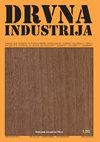几种常用计算机模型对胶粘剂固化性的预测
IF 0.8
4区 农林科学
Q4 MATERIALS SCIENCE, PAPER & WOOD
引用次数: 0
摘要
本研究的目的是使用软计算模型预测清漆的粘合强度,该清漆作为保护涂层/面漆应用于木质材料表面。在本研究中,将软计算方法应用于橡木(Quercus Petrea L.)、栗子(Castanea sativa M.)和苏格兰松(Pinus sylvestris L.)的水性、聚氨酯和丙烯酸清漆。清漆的粘合强度根据土耳其标准学会24624和ASTM D4541测定。实验结果用于开发人工神经网络(ANN)和模糊逻辑(FL)预测模型。360个数据点的总数被划分为模型开发的80%的训练和20%的测试。在ANN的应用过程中,6个特征被用作输入,而粘附强度被用作模型的输出。ANN模型中训练和测试的决定值系数(R2)分别为0.9939和0.9580。在ANFIS模型的情况下,训练和测试的R2值分别为0.9917和0.9929。考虑到从训练值和测试值的结果中获得的MAPE、RMSE和R2值,可以得出结论,ANFIS模型在估计清漆粘合强度方面表现出更成功的性能。因此,ANN和ANFIS有可能在估计木材粘合强度方面提供时间和成本效益。本文章由计算机程序翻译,如有差异,请以英文原文为准。
Predviđanje adhezivne čvrstoće nekih lakova uz pomoć modela mekog računalstva
The purpose of this study was to predict the adhesion strength of the varnish, which is applied as a protective coating/finish on the surface of wooden material using soft computing models. In this study, the soft computing approaches were applied to oak (Quercus Petrea L.), chestnut (Castanea sativa M.), and scotch pine (Pinus sylvestris L.) with water-based, polyurethane, and acrylic varnishes. The adhesion strength of the varnish was determined in accordance with the Turkish Standard Institute-24624 and ASTM D4541. The outcome of the experiment was used to develop artificial neural network (ANN) and fuzzy logic (FL) prediction models. The total number of 360 data points was split as 80 % of training and 20 % of test for the model development. During the application of the ANN, 6 features were used as an input, while the adhesion strength was used as an output of the model. The coefficient of determination values (R2) for training and testing in the ANN models were 0.9939 and 0.9580, respectively. In the case of the ANFIS model, R2 values for training and testing were 0.9917 and 0.9929, respectively. Considering the MAPE, RMSE, and R2 values obtained from the results of both training and test values, it can be concluded that the ANFIS model showed a more successful performance in estimating varnish adhesion strength. Therefore, ANN and ANFIS have the potential to provide time and cost-efficient benefits in estimating wood adhesion strength.
求助全文
通过发布文献求助,成功后即可免费获取论文全文。
去求助
来源期刊

Drvna Industrija
MATERIALS SCIENCE, PAPER & WOOD-
CiteScore
1.80
自引率
9.10%
发文量
32
审稿时长
>12 weeks
期刊介绍:
"Drvna industrija" ("Wood Industry") journal publishes original scientific and review papers, short notes, professional papers, conference papers, reports, professional information, bibliographical and survey articles and general notes relating to the forestry exploitation, biology, chemistry, physics and technology of wood, pulp and paper and wood components, including production, management and marketing aspects in the woodworking industry.
 求助内容:
求助内容: 应助结果提醒方式:
应助结果提醒方式:


